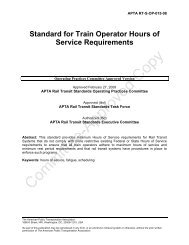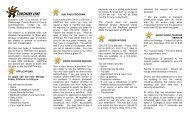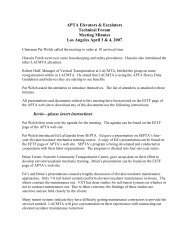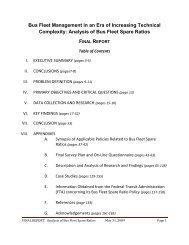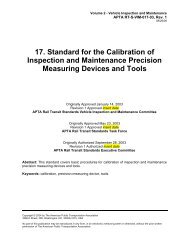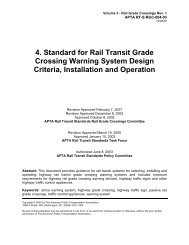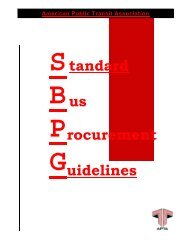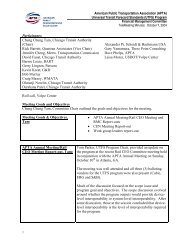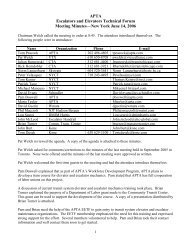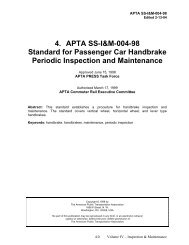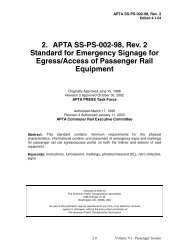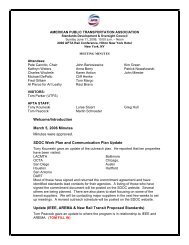Table of Contents - APTAStandards.com
Table of Contents - APTAStandards.com
Table of Contents - APTAStandards.com
You also want an ePaper? Increase the reach of your titles
YUMPU automatically turns print PDFs into web optimized ePapers that Google loves.
defines instruction, notification and advice message types for unique operating<br />
conditions. “Request-Response” message pairs were originally intended for exchange<br />
between an operator central system and a regional central system. However,<br />
depending on the system architecture, the message pairs can be configured for<br />
exchange between two operator central systems.<br />
Operator Central<br />
System<br />
4.1.7 Security Requirements<br />
Exhibit 4.1-5 Request Response Pair<br />
Regional Central<br />
System<br />
Request/Response Request/Response<br />
Request/Response<br />
Operator Central<br />
System<br />
The standard mandates th e last bit position within any message bit map to be reserved<br />
for<br />
the Message Authentication Code (MAC) data element to validate<br />
the source and<br />
the<br />
text <strong>of</strong> the message between the sender and the receiver. The standard also makes<br />
reference to ISO/IEC 9807 (Banking and Related Financial Services) for message<br />
authentication.<br />
4.1.8 Timing & Routing<br />
ISO Standard 8583 defines two alternative information exchange schemes including<br />
examples to ac<strong>com</strong>modate transfer <strong>of</strong> data, in a batch or a file transfer format, in<br />
addition to the standard real-time “request-response” messages. These alternative<br />
approaches can be especially beneficial in a back-end information exchange, where a<br />
real time transfer <strong>of</strong> data to the higher tier or the central system is not as critical. These<br />
two alternatives provide a viable foundation for information exchange between both<br />
intra<br />
agency system <strong>com</strong>ponents and different central systems that operate on a peer-topeer<br />
basis. Therefore these exchange schemes are applicable to the UTFS efforts.<br />
ISO/IEC 8583 describes a file transfer process that is designed to allow transfer <strong>of</strong> larger<br />
volumes <strong>of</strong> data in the minimum number <strong>of</strong> messages. The file transfer consists <strong>of</strong><br />
submission <strong>of</strong> a group <strong>of</strong> file action messages (300 series), where the total number <strong>of</strong><br />
Page 20



